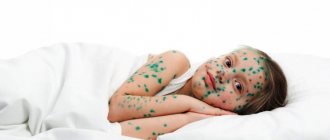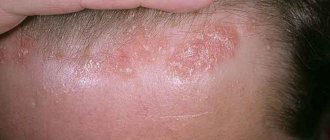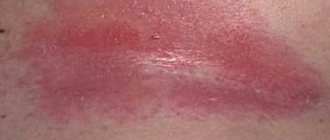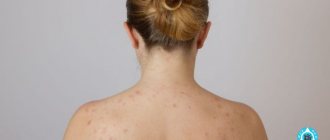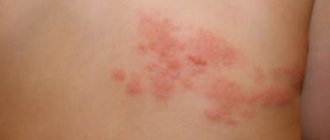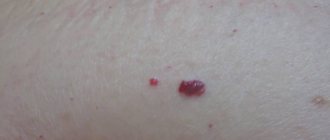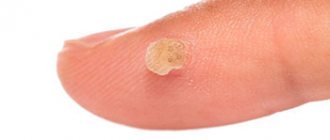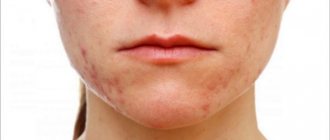Why do pimples appear around the mouth?
Pimples characteristic of this disease usually look like small reddish bumps.
They are also small in size compared to eels. The skin around these pimples is also inflamed and red or pink. Such rashes can affect the area of the mouth under the lower lip and in the triangle above the upper lip. If you have more than one pimple, the skin in this area becomes rough due to the large number of bumps. Even if after some time the rash goes away, then where they were, spots may remain that do not add attractiveness to the skin of the face.
Perioral pimples are also characterized by the fact that they do not occur on the area very close to the lips. Leaving a small rim around the mouth, they appear a little further from the lips and mouth. If pimples do appear almost on the lips, then their size and redness will be less than those that will be in the triangle above the upper and under the lower lip.
In rare cases, if treatment is not started in time and the disease progresses, the rash can reach the temple and the under-eye space.
Most people suffering from this disease claim that acne is not painful. They do not cause discomfort, do not hurt and do not burn. Only those patients whose acne has spread further than the area around the lips and mouth report mild itching and burning.
If you notice this kind of rash on your face around your mouth, do not panic, they are completely harmless to your health. However, they can bring psychological problems due to their cosmetic defect.
As we have already said, the risk group is mainly young women. Children and men suffer from this disease less often.
What causes the disease?
Despite the fact that medicine is now at a fairly high level, doctors still do not say what exactly causes the development of the disease.
However, the factors influencing the appearance of a rash around the mouth, as well as increasing the severity of acne, are already reliably known:
- One of the main causes of rashes around the mouth is the use of ointments and creams containing steroids, such as prednisolone or hydrocortisone; It has been experimentally proven that many people experience rashes after applying such products to their skin;
- The second most popular reason is the use of various cosmetics and care products, such as makeup removers, face creams and daily lotions. Of course, the main remedy that provokes the appearance of small rashes around the mouth is foundation. There are good quality creams that do not clog pores, and there are those that clog pores, which causes an inflammatory process;
- Weather events such as strong winds or direct sunlight can also cause a rash;
- There is controversy over fluoride toothpaste. Today, one thing can be said for sure - it is not a direct cause of perioral dermatitis, however, thanks to its effect on the skin, existing acne around the mouth becomes more pronounced;
- Quite often, this disease occurs as a result of the presence of bacteria and fungi living in the hair follicles. However, do not be misled by equating a perioral rash with a skin infection;
- Rashes around the mouth can appear due to hormonal imbalance. This is especially true for women when there is a change in hormonal levels before menstruation;
- There are cases when rashes around the lips and mouth are caused by women taking oral contraceptives, i.e. hormonal contraceptives. We advise you to stop taking these medications if you experience a rash around your mouth. An experienced dermatologist will prescribe a treatment that will eliminate the rash with minimal damage to the skin. You should also contact a gynecologist, who will competently select another means of contraception for you.
When should you see a doctor?
Review the following situations that require immediate treatment:
- If you have completely abandoned the use of decorative and skincare cosmetics, 2-3 weeks have already passed, and there has been no improvement in your condition;
- If for some reason you cannot 100% refuse to use cosmetics;
- If you want to eliminate rashes around the lips in less than one month;
- If you have a lot of inflamed pustules on your face and your skin is very flaky.
Frequently asked questions about pimples on the roof of the mouth
When should you see a doctor?
Pimples like this on the roof of your mouth most often disappear without any treatment within a week. Sometimes you may have a persistent pimple on the roof of your mouth as it comes back again and again after some time to disappear. If the pimple does not disappear after three or four weeks of use home remedies or appears again and again, consult your doctor immediately because it may be an indicator of some serious diseases such as oral cancer. If the spot is associated with any diagnosed disease, visit your doctor regularly to keep him updated about positive or negative changes in your condition.
Manifestation of skin rash
Cases of skin problems have only been documented in observational studies, so we cannot say with 100% certainty that they are symptoms of Covid. Skin rashes may appear as a reaction to medications. But still, WHO classified skin rashes as a symptom of a viral infection.
The prevalence of the rash is also not yet clear. If in China skin problems are observed in 0.3% of patients, then in Italy this value is 21%. Skin rashes can also appear with many other diseases, such as chicken pox, measles and herpes.
Causes of rashes on the oral mucosa in children and adults
The causes of oral rashes are numerous. Often, the presence of rashes in the mouth indicates dental diseases, dysfunction of organs and systems, and hormonal imbalances. The type of infection can be determined by the nature of the spots and accompanying symptoms. The dentist should make a diagnosis and determine a treatment regimen.
Viral and bacterial infection
Red spots on the palate of a child and a rash on the tonsils are most often caused by viral or bacterial infections. An infectious lesion in a child or adult is accompanied by a febrile state (fever, sore throat, and in some cases chills).
The cause of rashes can be influenza, chickenpox, diphtheria, ARVI, scarlet fever, meningitis and other serious diseases. At a young age, children often encounter stomatitis and herpes sore throat. These diseases are severe, accompanied by acute pain, attacks of nausea and bowel dysfunction.
Fungal infection
Spots that have arisen due to the penetration of fungal agents into the body require special attention. The most common fungal disease of the oral cavity is candidiasis (thrush). Caused by microscopic fungi of the genus Candida. Their activity increases after illness, when the immune system is weakened, when taking certain medications. You can distinguish such a rash in the mouth by a white coating in the oral cavity - on the cheeks, on the mucous membrane, on the tongue. The treatment regimen is chosen by the attending physician after determining the type of pathogen and depending on the patient’s medical indications.
Allergic reactions, poisoning
Enanthema in adults and children is often a consequence of an allergic reaction of the body or intoxication. In both cases, it is presented in the form of small red dots on the palate, tongue, and inner surface of the cheeks. Swelling of the soft tissues is also characteristic, which often leads to bronchospasm and Quincke's edema.
Any rash is a reason for medical examination. For effective treatment and elimination of associated symptoms, it is necessary to identify the allergen that provoked the pathological changes. The most common causes of enanthema of this etiology are:
- material for dental structures and fillings;
- Food;
- toothpastes, mouthwashes, brushes;
- medications;
- teethers, pacifiers.
With an allergic rash, there is no fever or other symptoms of infectious diseases. The rash is located symmetrically throughout the mucous membrane, in some cases it can occur in certain areas of the skin. In case of poisoning, swelling of the soft tissues, an increase in temperature are possible, and sometimes plaque appears on the tongue and the inner surface of the cheeks (on one or both sides).
Rare specific diseases (granuloma, petechiae, sarcoma)
Specks can sometimes indicate the presence of a rare specific disease. In this case, the rash looks like pinpoint red spots or looks like a large spot, located mainly in the throat and palate. The following pathologies are distinguished, characterized by similar symptoms:
- Kaposi's sarcoma. It presents multiple formations on the skin in the form of flat or convex plaques, has a bright purple color with additional shades (red, brown). Quite often it is diagnosed inside the oral cavity (on the palate), on the lymph nodes, and in rare cases - on the internal organs. The disease mainly develops in HIV-infected people.
- Pyogenic granuloma. A benign vascular formation that occurs in areas subject to frequent trauma or affected by staphylococcus. It has a red-cherry hue and looks like a dense rounded nodule. The pathology does not hurt, grows quickly and reaches its maximum size in just a few weeks.
- Palatal petechiae are scattered round spots on the palate or at the top of the oral mucosa (you can see the appearance of the rash in the photo).
What provokes
The cause of the appearance of white pimples in the oral cavity is considered to be disturbances in the functioning of the sebaceous glands. The formation goes away without drug therapy as the functioning of the glands is restored. Doctors identify 3 groups of causes that provoke white ulcerative formations.
- Local pathologies.
- Physical damage to the oral cavity.
- General diseases.
The first point includes the following diseases.
- Stomatitis is aphotic in nature, the pathology is accompanied by a chronic course. The main difference is considered to be abscesses, which add discomfort and pain while eating or during a conversation. The pathology requires treatment and resolves within 1 to 16 weeks, depending on the severity of development.
- Herpes stomatitis. The main feature is the formation of ulcerative foci of a reddish hue, having a watery structure. Ulcers occur not only on the mucous membrane, but also on the tongue. They pass within 7 – 14 days.
- Ordinary stomatitis is also a provoking factor in the development of white pimples in the mouth.
- Periadenitis is necrotic in nature, accompanied by frequent relapses. The pathology is characterized by sharp painful sensations and prolonged development. The progression of the disease is accompanied by aphthae with accumulations of blood in the center.
- Ulcerative lesions with a yellowish tint also provoke the appearance of acne in the oral cavity.
Do you feel nervous before visiting the dentist?YesNo
The appearance of white rashes is explained by mechanical injuries.
- Biting the tongue with fangs or other teeth. There is a high risk of the onset of an inflammatory process, which leads to the formation of white rashes.
- In the process of brushing your teeth, damage to the oral mucosa with a toothbrush is possible, this is especially true for brushes with hard bristles.
- Various chemical elements can provoke the development of ulcerative lesions.
- With sharp edges of the dentition, there is a high probability of injury to the mucous membrane, which also includes the installation of fillings by an incompetent doctor.
- If the brackets are incorrectly sized, gum injury may occur.
- White rashes occur when injured by medical instruments during the treatment of dentition or other diseases of the oral cavity.
Pathologies of a systemic nature are also one of the reasons for the appearance of white pimples in the mouth.
- Gingivostomatitis of the necrotic variety. Develops with a weakened immune system and the progression of viral pathologies. Gingivostomatitis can also be caused by an allergic reaction. The mucous surface is characterized by ulcerative lesions with a blurred greenish texture. Blood may be discharged.
- Tuberculosis of the pulmonary system is another cause of the occurrence of white rashes in the oral cavity; the development of ulcerative lesions with bloody cells, characterized by a loose structure, is noted.
- Syphilis is one of the provoking factors. Its appearance is explained by treponoma, which increases the risk of boils characteristic of the pathology.
- Human immunodeficiency virus, which negatively affects the gums.
Also, white rashes occur with diseases of the gastrointestinal tract of a chronic nature, this also includes dysbacteriosis.
Diseases of the heart and vascular system also provoke the appearance of white rashes. Diabetes and other endocrine disorders increase the risk of developing oral acne.
Types of rash
On the body: stomach, back, chest
The most common location on the body was the anterior surface - rashes were found on the stomach and chest, less often the elements were located on the back. In these areas the following were discovered:
- small bubbles;
- papules (nodules) raised above the surface of the skin;
- pinpoint hemorrhages;
- red spots with blisters, sometimes accompanied by pain and itching.
On the scalp, face
No isolated lesions of the scalp and face were detected with coronavirus, but with a widespread rash, it covers the shoulders in adults, the neck and the skin under the hair; individual elements of the rash are found on the cheeks and forehead.
In the mouth, throat
A rash in the throat and mouth with coronavirus has not yet been described; such lesions are typical for sore throat associated with herpes and influenza. In an adult with spots on the oral mucosa, viral pharyngitis and infectious mononucleosis may occur, and in a child it is important to exclude measles, scarlet fever and chickenpox. All of them can be accompanied by fever, general weakness and headache.
Tests for coronavirus infection can help make a diagnosis.
Rash on extremities similar to frostbite
The appearance of a rash on the legs and arms was observed in approximately 20% of cases. Patients often complained of itching and painful sensations when touched. In most cases, such a rash appears in young people who experience a mild form of the disease.
The rash usually appears later than other common symptoms and lasts about 2 weeks.
Blisters
In some patients (16%), very small blisters of the same size and shape appear on the stomach and back. Slightly less often, such blisters appear on the arms and legs (10%).
Blisters most often appear in patients aged 35-55 years and are accompanied by unbearable itching. This rash lasts an average of 10 days.
Maculopapular rash
It looks like small red bumps. In some cases, it may appear along with other common symptoms. Their duration is 8-10 days. It is the most dangerous and common type of rash due to coronavirus (48%).
Hives
The rash, similar to hives, resembles a large number of small bumps that are red or white and very itchy. Many people infected with Covid experienced such a rash on all parts of the body, including on the palms of their hands. Its duration is 7-9 days and is most often observed in patients with a severe form (20%).
Livedo
It is the main sign of tissue death and circulatory problems. It appears as a purple mesh pattern on the skin. Most often occurs in elderly patients with severe disease. This type of rash is very rare.
Frequent skin symptoms
The most common variant of skin diseases associated with coronavirus are erythematous-edematous lesions. The spots may vary in diameter and have different shades of red. They do not itch and do not cause any particular discomfort or pain. The affected areas of the skin become warm and sometimes hot.
There are also pink rashes. They are oval in shape and flaky. They are usually found on the sides of the body and can itch, causing severe discomfort.
Skin rashes do not appear in a chaotic manner. Most types of rashes are characteristic of a certain age category or form of the disease.
In children
Children are more likely to develop a rash in the mouth, and this is due to several factors^
- Firstly, babies do not yet have a strong enough immune system.
- Secondly, they are prone to childhood diseases that cause rashes (smallpox, measles).
- Thirdly, children often forget to wash their hands and put unwashed vegetables and fruits in their mouths, which significantly increases the chances of infection.
With measles, white rashes form on the mucous membrane of the child's mouth on the tongue and cheeks. With scarlet fever, the rash is quite small, but abundant, and diphtheria can be recognized by the characteristic films around the tonsils.
One of the most common causes of rash in children is stomatitis. Most often it occurs as a result of the harmful effects of pathogens.
In adults
Adults may have the same reasons as children. Stomatitis in adults often occurs not due to the consumption of dirty fruits or vegetables, but due to bacteria that arise from an infectious disease of the teeth or respiratory system.
This pathology is accompanied by pain, general weakness, constant fatigue, and loss of appetite.
Herpetic sore throat is another reason for the appearance of pimples in the mouth. This is a viral disease characterized by rashes that visually resemble herpes. After a few days of disease development, they turn into ulcers. Treatment consists of rinsing the mouth and taking antiviral drugs.
Pimples on the palate of a child's mouth
Poll: When did your acne appear? (Number of votes: 4295)
I've been suffering all my life
It's been a couple of years now
About a few months
Recently
To vote, click on the desired answer. results
Pimples on the roof of the mouth in a baby or preschool child can also be caused by Epstein's pearly disease, which are common, benign, painless cysts that affect about 80% of babies. Also known as palatal or gingival cysts, these pimples are white or yellowish bumps found more commonly all over the roof of the mouth They can be mistakenly perceived as growing teeth, however, you can also understand that these are pimples when wearing glasses.
Epstein pearls form in the uterus when the mucous membranes become trapped during palatal formation.
These oral pimples do not require any treatment because they are harmless, painless, and usually disappear within a few weeks. If Epstein's pearls are still present after a few weeks, discuss their treatment with your doctor.
Stomatitis
These are bumps (canker sores) that appear on the roof of the mouth, the base of the gums, and the inside of the cheeks and lips. The root cause of these pimples is unknown, but they are thought to be caused by allergies, hormonal imbalances, menstrual periods, poor diet, and stress. Trauma to oral tissues. ulcers, such as recent dental work or cheek biting, can also lead to ulcers, particularly in a child.
If there is pain or great discomfort, ask your doctor to drain the injury using a sterile needle.
Herpes
Cold sores (fever) are a group of small pimples in and around the mouth, including the roof of the mouth areas. The area around these bumps is often red, swollen and tender. They are caused by the herpes simplex virus. Herpes is highly contagious and easily spread from one person to another. Once they appear, these pimples break open , infectious fluid leaks out, scab They disappear on average after two weeks. They are accompanied by pyrexia or fever and swollen glands.
If the situation gets worse, see your doctor for treatment.
White pimples on the roof of the mouth photo
Causes of rashes around the mouth in a child
A rash around the mouth in a child of any age can occur due to various reasons. The accompanying symptoms will help determine what exactly led to the appearance of this unpleasant phenomenon, but you should not neglect consulting a doctor - after all, there is always a risk of making a mistake when trying to diagnose a child on your own.
Teething
Irritation and red pimples around a baby’s mouth often occur during teething. When a baby is teething, salivation becomes especially intense. Saliva flows down the chin, the skin in this area is constantly moisturized, and over time, acne appears, covered with crusts. The phenomenon does not require general therapy - only hygiene and treatment with external agents.
Improper hygiene
Children often neglect simple hygiene rules, which causes the development of many pathological processes. If a child puts dirty hands into his mouth or wipes his lips without leaving the playground, and forgets to wash his hands upon returning home, there is a risk of introducing dirt into microtraumatic skin lesions. Then small red pimples will not keep you waiting.
Worm infestation
Infection of a child's body with parasites, for example, worms, can also manifest itself through a symptom such as reddish rashes on the face. It is difficult to determine helminthic infestation by indirect signs. The only reliable way is to do tests, including a blood test for eosinophil levels. If the indicators are elevated, it means that there is an infection with parasites.
Local hypothermia
Parents often encounter redness on their children’s facial skin during the winter. A child's skin is very delicate, so severe frost (especially in combination with a piercing icy wind) can damage the skin and cause a reaction in the form of small wounds and pink pimples. Hypothermia rashes can occur on any exposed areas of the skin.
Digestive problems
Pimples near the mouth, eyes and on the cheeks, a little like lichen, but without itching or burning, sometimes indicate problems in the child’s digestive system. If a small patient periodically suffers from constipation and irregular bowel movements, and food is not completely digested, this negatively affects the body and often manifests itself through skin symptoms. This reason is one of the most difficult to determine.
How not to confuse a papule in the mouth from manifestations of syphilis
A characteristic and indicative difference between syphilomas is their painlessness and resistance to the influence of many medications (including antibiotics).
These facts are special signs of this venereal disease. Having discovered a papule with a white coating on the oral mucosa, which does not manifest itself as additional symptoms in the form of pain, you must immediately consult a specialist to prevent the development of the disease and exclude possible complications. The article has been verified by the editors
What diseases can cause a rash?
The rash can be caused by many diseases of different etiologies, for example:
- Viral infections (herpes, enterovirus infection, etc.).
- Allergic reactions.
- The presence of parasites in the body.
- Atopic dermatitis.
- Colds, etc.
But you can find out the true cause of the pathology only by contacting a specialist.
Exudative-catarrhal diathesis
Diathesis occurs with the development of allergic reactions (usually in the form of allergic dermatitis) and has reduced resistance to infectious pathogens. The pathology is most often diagnosed in newborns up to 6 months. Symptoms appear over 1-2 years, then disappear without a trace.
The pathology occurs with itchy nodules on the face, thickening and peeling of the skin on the cheeks, diaper rash, and seborrheic scales on the scalp. Most patients develop diseases that occur in the oral cavity (glossitis, gingivitis, etc.) and eyes (blepharitis, conjunctivitis, etc.).
Lymphatic diathesis
Lymphatic diathesis is characterized by the development of abnormalities in the constitution.
The pathology appears by the age of 2-3 years and, with proper therapy, disappears by puberty. In some cases, symptoms are present throughout life.
Symptoms characteristic of the disease:
- disproportionate physique, for example, lengthening of the limbs and shortening of the torso as one grows;
- weakening of muscles;
- decreased skin turgor, pallor of the epidermis;
- malaise;
- enlarged lymph nodes;
- splenomegaly and hepatomegaly (enlarged spleen and liver, respectively).
Irritation on the face with lymphatic diathesis rarely occurs.
Atopic dermatitis
Red watery blisters near the lips and around the mouth, in another area of the face - a symptom of atopic dermatitis . New growths have the ability to merge with each other, forming round conglomerates. The provoking factor is a decrease in the body’s defenses or heredity. If you do not start fighting the disease in a timely manner, the risk of pathology developing into eczema increases.
Enteroviral stomatitis
Severe irritation around the nose and mouth occurs with enteroviral stomatitis . The disease is also characterized by the appearance of ulcerative tumors in the oral cavity. Red pimples appear on the face, which is accompanied by vomiting and diarrhea, lymphadenitis, malaise, and fever.
Chicken pox
The main symptom of chickenpox is a rash on the skin of the entire body, not just around the mouth and face. Concomitant clinical manifestations of the pathology are malaise, headache and muscle pain, increased general temperature (not in all cases).
Perioral dermatitis
Redness of the skin around the mouth, small red dots that can merge with each other are symptoms of perioral dermatitis . Neoplasms at an advanced stage form continuous large conglomerates.
Possible complications
Taking good care of your child's oral cavity will help avoid serious complications. Parents need to remember that not every pimple or ulcer signals a serious pathology. The main reason for their appearance is damage to the oral mucosa. However, you should be wary of such things as frequent and painful inflammatory processes that bother the baby and provoke a rise in temperature. In these cases, stomatitis is a symptom:
Timely diagnosis and treatment minimize the negative consequences of the above diseases. So, complications of measles, for example, are pneumonia, otitis media and laryngitis, and tonsillitis – arthritis, pyelonephritis, rheumatism.
Associated symptoms
A rash in the mouth is rarely an independent disease. In most cases, the appearance of blisters or ulcers on the tissues of the oral cavity is associated with the development of some kind of systemic pathology and infection. Accordingly, patients also exhibit other symptoms:
- People often notice an increase in body temperature. Fever indicates the presence of an inflammatory process or tissue infection.
- The appearance of rashes is often accompanied by severe itching and a burning sensation.
- Soreness, redness, and swelling of the mucous membrane are also possible.
- Enlarged lymph nodes, along with a rash, often indicate an infectious disease.
- The appearance of rashes in other areas of the skin and mucous membrane.
- Cancers are often accompanied by painless rashes along with unexplained weight loss and general weakness.
Symptoms of thrush
The appearance of small whitish spots on the tongue, cheeks, gums and mucous membrane of the palate are among the first signs of the disease. After a short period of time, they increase in size and merge, forming a coating called curd-like. Then its color changes to yellowish or gray. It is not possible to remove plaque with a spatula. Thrush in a baby's mouth causes anxiety and moodiness. It hurts for the baby to breastfeed. In addition, the baby has other manifestations:
Delayed diagnosis and lack of treatment is fraught with serious complications: a grayish-white film spreads throughout the body, covering the esophagus and upper respiratory tract. And if it gets into the bloodstream, there is a high probability of developing a septic condition.
Diagnosis of rashes
Symptoms such as irritation and peeling, itching around the mouth and other skin manifestations may have an allergic etiology, infectious or autoimmune. In the latter case, in addition to the skin rash, there is damage to other organs and systems, as well as general intoxication of the body.
First of all, when visiting a doctor with irritation around the mouth in a child or adult, information is collected about how long ago the symptoms occurred, their nature, and accompanying manifestations. An allergic history is examined to determine whether there have been cases of a similar reaction in the past. The hereditary factor is no less important.
To identify the allergen, allergy tests are performed. Differential analysis involves a biochemical study of salivary fluid or exudate from the mucous membrane, which makes it possible to identify or exclude bacterial infections.
If there is a suspicion of the development of a gastrointestinal disease, additional measures are taken:
- general and biochemical blood test;
- coagulogram;
- study for hepatitis markers;
- coprogram;
- endoscopic examination;
- colonoscopy;
- endoscopy;
- ultrasound analysis of internal organs.
It is possible to determine how to treat redness and peeling around the mouth, rash, and itching syndrome only after making a final diagnosis.
Some treatment features
Therapy should be aimed at eliminating the root cause and alleviating the condition of the little patient. In case of mechanical damage to the oral mucosa, the wound surface is treated, having previously removed the foreign object. If chronic pathologies are the cause of white pimples in a child’s mouth, comprehensive treatment is recommended using medications from different pharmacological groups:
A prerequisite for successful treatment is maintaining oral hygiene and drinking plenty of fluids.
Measures to take if a rash appears
You cannot start treatment on your own ; you must undergo an examination by a dermatologist, gastroenterologist, and pass the necessary tests for the content of hormones in the blood.
As a preventive measure, you need to strengthen your immune system, take care of facial hygiene, do not use cheap cosmetics, and do not self-medicate with hormonal drugs.
Which rash is dangerous?
A rash with purulent contents that quickly spreads to other areas of the skin (including when the papules merge with each other) and is accompanied by symptoms such as nausea, vomiting, bowel dysfunction, loss of appetite, increased body temperature, etc. should cause concern. d. In this case, you should immediately consult a doctor. If the rash has a pinkish tint, and the pimples do not have purulent contents and do not cause much concern to the child, it is unlikely that there is anything serious in this case; most likely, there is an allergy or a cold.
Rash symptoms
If a rash on a child’s gums is not caused by injury, the following conditions of the baby will be associated symptoms:
- heat;
- baby’s bad mood, moodiness;
- decreased appetite;
- cloudy gum plaque;
- nausea, vomiting, headaches;
- bleeding gums;
- swelling of soft tissues.
Also, the mucous membrane of soft tissues can be covered with bruises, hematomas, and abrasions.
Whatever the cause of the rash, it must be diagnosed and treated. For this, the child must be examined by a pediatric dentist and prescribed the necessary therapy.
Treatment methods
If a child has a rash around the mouth, then the further actions of the parents depend on the condition of the baby and the reasons that caused such a reaction. There are traditional methods and medications to treat rashes.
Usually, parents are in no hurry to use medications without special reasons and doctor’s recommendations. In this case, traditional medicine will come to the rescue, which is suitable for treating the rash without complications.
If the cause of the rash is irritation on the skin under the influence of external factors, then heated vegetable oil is used. They need to lubricate the damaged areas of the skin in a small amount three times a day. Among medical products, Bepanten is a good choice.
If prickly heat appears, baths with medicinal herbs will come to the rescue, which will have a gentle drying effect on the skin. For their preparation, string, calendula flowers and chamomile are used. To prepare the decoction you need:
- 1 glass of water;
- 1 tablespoon of dry herbs of medicinal plants.
- Boil the herb for a minute.
- Strain the cooled broth and add it to the baby’s bath.
In case of an allergy to a vaccine, the medications “Fenistil” and “Zodak” will cope with the rash much more effectively. As a preventive measure, they can be consumed a couple of days before vaccination and one day after in a volume of 5-10 drops, depending on the age and weight of the child.
Fenistil ointment copes well with allergies to insect bites. It is necessary to lubricate the rash areas twice a day. Until the symptoms of itching and swelling decrease.
Among the folk remedies for allergies, mumiyo is very popular. For this method, it is recommended to purchase mumiyo in the form of resin:
- 1 bag of mumiyo;
- 500 ml water.
The dissolved mummy gives the water a dark brown color and the water loses its transparency. Children should take this solution in the morning:
- 1-3 years 50 ml;
- 4-7 years 70 ml;
- From 8 years – 100 ml.
The course of treatment for mumiyo is 20 days.
Folk remedies
Along with drug therapy, safe and time-tested folk remedies are allowed. Here are some of them:
- A mixture of honey and onion juice (the ingredients are taken in equal proportions), which is boiled for 10 minutes and cooled to room temperature. The resulting mass is applied to the affected areas 2 times a day.
- Lotions with soda solution - dissolve 1 tsp in a glass of warm water. baking soda and apply to the skin around the mouth. Frequency of use: 2 times a day.
- Lotions made from fresh pumpkin juice - freshly squeezed juice is applied to problem areas in the form of lotions. The procedure is repeated 2-3 times a day.
- Raw potatoes - potatoes are peeled, grated on a fine grater and applied to the area around the mouth 3-4 times a day. The product is effective in the case of atopic dermatitis.
If you have an allergic reaction to one or another component in the product (severe itching, redness of the skin, etc.), treatment should be stopped and you should consult a pediatric dermatologist or pediatrician.
Medicines against rashes in the mouth
Treatment of skin rashes in an adult or child involves the use of medications, physiotherapeutic procedures and traditional medicine recipes.
Among the medications used in the treatment of rashes:
- antihistamines;
- enzymatic preparations;
- enterosorbents;
- healing and restorative agents for local use;
- antibiotics;
- hormonal ointments;
- vitamin and mineral complexes;
- immunostimulants;
- antibacterial agents.
The choice of drug depends on the type of rash, the cause of its occurrence, as well as the individual characteristics of the body.
Preventive actions
Ulcers on the mucous membrane, rashes near the mouth in women and men are, to say the least, unpleasant phenomena. And sometimes it is much easier to prevent the development of diseases. The rules of prevention are simple:
- adhere to hygiene standards;
- limit contact with infectious patients, avoid sharing dishes, towels and other household items;
- stop smoking, as cigarette smoke damages the mucous membrane of the mouth;
- try to prevent mechanical damage to the tissues of the oral cavity (for example, it is worth remembering that the food consumed should not be too hot or hard);
- use condoms during sexual intercourse.
Of course, if a rash appears on the tissues of the oral cavity or near the lips, you should consult a doctor. The sooner treatment is started, the easier it will be to cope with the disease.
Sources
- https://allergology.ru/lico/pryschi-v-oblasti-rta-vokrug-gub
- https://aptstore.ru/articles/kozhnye-problemy-pri-koronaviruse/
- https://AzbukaZubov.com/rebenok/polost-rta/vysypaniya-vo-rtu.html
- https://endokrinolog.online/syp-pri-koronaviruse/
- https://stomaudit.ru/syp-na-slizistoj-polosti-rta/
- https://www.deti34.ru/simptomy/kozha/syp-vokrug-rta-u-rebenka.html
- https://DetMed.info/syp-vokrug-rta-u-rebenka
- https://dermgid.com/simptomi/prochee/razdrazhenie-vokrug-rta-u-rebenka.html
- https://FB.ru/article/370031/vyisyipanie-vo-rtu-foto-prichinyi
- https://www.gomeo-patiya.ru/simptomy/syp-vokrug-rta-u-vzroslogo-215.html
- https://allergology.ru/kozhnye/chem-opasna-syp-vokrug-rta
- https://allergick.ru/syp-vokrug-rta/
Causes and symptoms of papules in the mouth and tongue
Chancres are neoplasms that appear during primary and secondary syphilis. They are covered with a whitish coating and have a hyperemic rim around the ulcer. The wound itself on the oral mucosa does not cause pain or other sensations. If neoplasms appear on the back wall of the throat, the inside of the cheek, or the palate, then often the patient himself does not notice such manifestations of a sexually transmitted disease for some time. These white papules in the mouth are characterized by a round shape, ragged edges, and have shallow tissue damage. The plaque covering the chancre is nothing more than an accumulation of infection that causes this chronic disease.
The causative agent of syphilis is Treponema pallidum or spirochete pallidum. Entering the human body through damage to the epidermis (abrasions, scratches, bites), treponema penetrates into the thickness of the tissue, where chancre is formed. This compaction on the mucous membrane is the site of localization of the pathogen. Then the papule bursts and an ulcer forms, which can reach 2-3 cm in diameter. This area is considered by a specialist to be the site of primary infection.
We recommend reading:
- How is papulopustular acne treated?
- Why do red papules appear on the body?
- Reasons for the appearance of a wen on the lip
The most common methods of transmission of infection are presented in the table.
| Path of infection | Methods of infection |
| Straight. | 1. Direct oral contact with a virus carrier. This could be unconventional sexual intercourse or a regular kiss. |
| 2. Use of non-sterile working instruments by a dentist, ENT specialist, therapist, infectious disease specialist and other specialists. | |
| 3. A mother suffering from this disease can infect her child during her pregnancy, lactation or natural childbirth. | |
| 4. Medical workers who have contact with the patient’s secretions, saliva, and blood are exposed to infection. The risk group includes gynecologists, obstetricians, infectious disease specialists, dentists, surgeons, venereologists, and urologists. | |
| Indirect. | 1. The household method of transmission of infection is characterized by the use of the same dishes, washcloth, towel, bed linen and other items with a sick person. With secondary syphilis, almost the entire body of the patient is covered with rashes, each element of which contains spirochetes. The species of bacteria is distinguished by its survivability and resistance to many antibiotics. Once in the external environment, the pathogen is quite viable for some time. A healthy person, having damage to the skin, even the most minor, can become infected by getting treponema from papules on the patient’s skin into the wound. For children and adolescents, this method is a common cause of syphilis infection. |
